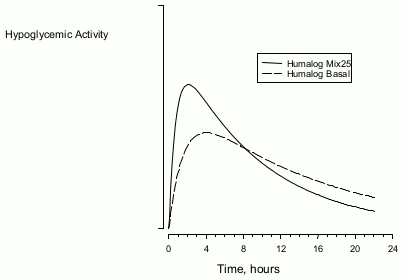HUMALOG Mix25 100 units/ml Suspension for injection in vial / cartridge / KwikPen pre-filled pen Ref.[8012] Active ingredients: Insulin lispro
Source: European Medicines Agency (EU) Revision Year: 2018 Publisher: Eli Lilly Nederland B.V., Papendorpseweg 83, 3528 BJ, Utrecht, The Netherlands
Pharmacodynamic properties
Pharmacotherapeutic group: Drugs used in diabetes, insulins and analogues for injection, intermediate or long acting combined with fast acting
ATC Code: A10AD04
The primary activity of insulin lispro is the regulation of glucose metabolism.
In addition, insulins have several anabolic and anti-catabolic actions on a variety of different tissues. Within muscle tissue this includes increasing glycogen, fatty acid, glycerol and protein synthesis and amino acid uptake, while decreasing glycogenolysis, gluconeogenesis, ketogenesis, lipolysis, protein catabolism and amino acid output.
Insulin lispro has a rapid onset of action (approximately 15 minutes), thus allowing it to be given closer to a meal (within zero to 15 minutes of the meal) when compared to soluble insulin (30 to 45 minutes before). The rapid onset and early peak of activity of insulin lispro is observed following the subcutaneous administration of Humalog Mix25. Humalog BASAL has an activity profile that is very similar to that of a basal insulin (NPH) over a period of approximately 15 hours.
Clinical trials in patients with type 1 and type 2 diabetes have demonstrated reduced postprandial hyperglycaemia with Humalog Mix25 compared to human insulin mixture 30/70. In one clinical study there was a small (0.38 mmol/l) increase in blood glucose levels at night (3a.m.).
In the figure below the pharmacodynamics of Humalog Mix25 and BASAL are illustrated.
The above representation reflects the relative amount of glucose over time required to maintain the subject’s whole blood glucose concentrations near fasting levels and is an indicator of the effect of these insulins on glucose metabolism over time.
The glucodynamic response to insulin lispro is not affected by renal or hepatic function impairment. Glucodynamic differences between insulin lispro and soluble human insulin, as measured during a glucose clamp procedure, were maintained over a wide range of renal function.
Insulin lispro has been shown to be equipotent to human insulin on a molar basis but its effect is more rapid and of a shorter duration.
In two 8-month open label crossover studies, type 2 diabetes patients who were either new to insulin therapy or already using one or two injections of insulin, received 4 months of treatment with Humalog Mix25 (used twice daily with metformin) and insulin glargine (used once daily with metformin) in a randomised sequence. Detailed information can be found in the following table.
| Insulin-Naive Patients n=78 | Not Insulin-Naive Patients n=97 | |
|---|---|---|
| Mean total daily insulin dose at endpoint | 0.63 units/kg | 0.42 units/kg |
| Haemoglobin A1c -Reduction1 | 1.30% (mean at baseline = 8.7%) | 1.00% (mean at baseline = 8.5%) |
| Reduction of the mean of combined morning/evening two-hour postprandial blood glucose1 | 3.46 mM | 2.48 mM |
| Reduction of the mean fasting blood glucose1 | 0.55 mM | 0.65 mM |
| Incidence of hypoglycaemia at endpoint | 25% | 25% |
| Bodyweight gain2 | 2.33 kg | 0.96 kg |
1 from baseline to end of Humalog Mix25 treatment
2 in patients randomised to Humalog Mix25 during the first crossover period
Pharmacokinetic properties
The pharmacokinetics of insulin lispro reflect a compound that is rapidly absorbed, and achieves peak blood levels 30 to 70 minutes following subcutaneous injection. The pharmacokinetics of insulin lispro protamine suspension are consistent with those of an intermediate acting insulin such as NPH. The pharmacokinetics of Humalog Mix25 are representative of the individual pharmacokinetic properties of the two components. When considering the clinical relevance of these kinetics, it is more appropriate to examine the glucose utilisation curves (as discussed in 5.1).
Insulin lispro maintains more rapid absorption when compared to soluble human insulin in patients with renal impairment. In patients with type 2 diabetes over a wide range of renal function the pharmacokinetic differences between insulin lispro and soluble human insulin were generally maintained and shown to be independent of renal function. Insulin lispro maintains more rapid absorption and elimination when compared to soluble human insulin in patients with hepatic impairment.
Preclinical safety data
In in vitro tests, including binding to insulin receptor sites and effects on growing cells, insulin lispro behaved in a manner that closely resembled human insulin. Studies also demonstrate that the dissociation of binding to the insulin receptor of insulin lispro is equivalent to human insulin. Acute, one month and twelve month toxicology studies produced no significant toxicity findings.
Insulin lispro did not induce fertility impairment, embryotoxicity or teratogenicity in animal studies.
© All content on this website, including data entry, data processing, decision support tools, "RxReasoner" logo and graphics, is the intellectual property of RxReasoner and is protected by copyright laws. Unauthorized reproduction or distribution of any part of this content without explicit written permission from RxReasoner is strictly prohibited. Any third-party content used on this site is acknowledged and utilized under fair use principles.
